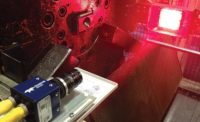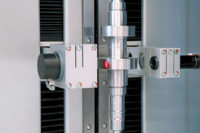Perfecting Gap Dimensions in Auto Assembly
German automobiles stand worldwide for high quality down to the smallest detail. “There is no second chance for a first impression” is the motto of German engineers and designers. And in fact, perceived quality is a big factor in the decision to purchase a vehicle. The precise fit of body parts, such as doors, with the smallest and most uniform gaps possible, plays a decisive role. That makes the requirements of automotive manufacturers’ production processes all the higher.

This was recognized by the engineers at EDAG (Fulda, Germany), an independent development partner of the mobility industry. The company worked with Allied Vision Technologies (Newburyport, MA) to develop an intelligent sensor for use with the EDAG Best-Fit image processing system and other applications. In the first step, a pilot system was implemented at the main EDAG location, in collaboration with GM/Opel.

Depending on the design of the attached part, six to 11 EDAG VarioGauge V4 sensors are installed on the gripper of the robot. In addition to electronic control and monitoring systems, the intelligent sensor EDAG VarioGauge V4 consists of a laser source and a digital camera from Allied Vision. With the aid of these sensors, the components-for example, door and sidewall-are measured against each other. The EDAG Best-Fit system detects the current status quo of the alignment along with the width and distribution of the gap dimensions and calculates the optimal position for installation. The software ensures not only the most parallel possible gap dimensions, but also uniform distribution of the gap dimensions at all measurement positions.
For the Best-Fit system, EDAG uses cameras belonging to Allied Vision’s Marlin family. For better integration in the EDAG VarioGauge sensor, the housing of the standard camera was removed and the board-level version was selected. With a resolution of 1.4 megapixels, the cameras permit precise gap measurements. In addition, the cameras are equipped with a digital interface-FireWire IEEE 1394a. This interface can be used to activate all the cameras of the EDAG Best-Fit system via a broadcast trigger. Because of the internal memory and the deferred mode, the Best-Fit system can flexibly call up the images of each camera for analysis.
“The deferred mode of the Marlin cameras from Allied Vision is the best match for the Best-Fit application,” explains Christian Böttcher, technical manager for image processing technology, and Christian Körbel, sales manager system technology of EDAG. “The industrial suitability of the FireWire interface was important to us in selecting a camera. We were able to design a special hub with fiber optic data transmission from the assembly gripper to the Best-Fit computer (VarioInspector), which makes the image processing technology immune to electrical and magnetic interferences within the system.”
The EDAG Best-Fit system is now being used at two European locations, for all the attached parts of the Mercedes Benz S-Class and the doors of the Opel Corsa. The system also is being used for other applications, such as the positioning of robot tools used for punching, stamping or riveting in automobile production.
Allied Vision Technologies
(978) 225-2030
www.alliedvisiontec.com
- In addition to quality advantages, the system also reduces rework costs.
- The system is currently in use at two European locations.

Conventional Processes Fall Short
In automobile construction, attached components are assembled predominantly using conventional methods with gages. These gages assume that the attached components are in a constant, rigid position for installation. This means that in some cases substantial rework has to be invested during production for manual adjustment. Uniform distribution of gap dimensions, as required today by both designers and quality engineers, can be challenging using conventional methods, and rework is expensive.This was recognized by the engineers at EDAG (Fulda, Germany), an independent development partner of the mobility industry. The company worked with Allied Vision Technologies (Newburyport, MA) to develop an intelligent sensor for use with the EDAG Best-Fit image processing system and other applications. In the first step, a pilot system was implemented at the main EDAG location, in collaboration with GM/Opel.

Sensor-Controlled Assembly
The Best-Fit system is a sensor-based assembly process that makes custom-tailored, highly precise assembly of attached parts in automotive production possible. For example, for door installation sensors first determine the dimensions of the gap and transition for each manufactured door along with the cut-out in the side wall of each corresponding vehicle; then calculate the optimal position of installation of that door with respect to that car body; and finally use robots to target this position precisely. The joining robot then installs the door so that it meets the requirements for a high-quality vehicle, despite the unavoidable geometric variations because of production tolerances. A particular feature of the EDAG Best-Fit system is that it learns and thus independently controls placement behavior in the joining process. Beyond that, a final quality inspection step is carried out and documented, so that downstream measurement stations can be eliminated.Depending on the design of the attached part, six to 11 EDAG VarioGauge V4 sensors are installed on the gripper of the robot. In addition to electronic control and monitoring systems, the intelligent sensor EDAG VarioGauge V4 consists of a laser source and a digital camera from Allied Vision. With the aid of these sensors, the components-for example, door and sidewall-are measured against each other. The EDAG Best-Fit system detects the current status quo of the alignment along with the width and distribution of the gap dimensions and calculates the optimal position for installation. The software ensures not only the most parallel possible gap dimensions, but also uniform distribution of the gap dimensions at all measurement positions.
For the Best-Fit system, EDAG uses cameras belonging to Allied Vision’s Marlin family. For better integration in the EDAG VarioGauge sensor, the housing of the standard camera was removed and the board-level version was selected. With a resolution of 1.4 megapixels, the cameras permit precise gap measurements. In addition, the cameras are equipped with a digital interface-FireWire IEEE 1394a. This interface can be used to activate all the cameras of the EDAG Best-Fit system via a broadcast trigger. Because of the internal memory and the deferred mode, the Best-Fit system can flexibly call up the images of each camera for analysis.
“The deferred mode of the Marlin cameras from Allied Vision is the best match for the Best-Fit application,” explains Christian Böttcher, technical manager for image processing technology, and Christian Körbel, sales manager system technology of EDAG. “The industrial suitability of the FireWire interface was important to us in selecting a camera. We were able to design a special hub with fiber optic data transmission from the assembly gripper to the Best-Fit computer (VarioInspector), which makes the image processing technology immune to electrical and magnetic interferences within the system.”
Milestone for Quality
The EDAG Best-Fit system is a milestone for assembly quality in automotive production. For each manufactured component and each manufactured body, the system calculates the optimal position for assembly-for a consistently uniform and high-quality appearance of the overall vehicle. But in addition to the quality advantage of perfect distribution of gap dimensions, the EDAG Best-Fit system also achieves economic advantages: The costs of manual readjustment are reduced drastically.The EDAG Best-Fit system is now being used at two European locations, for all the attached parts of the Mercedes Benz S-Class and the doors of the Opel Corsa. The system also is being used for other applications, such as the positioning of robot tools used for punching, stamping or riveting in automobile production.
Allied Vision Technologies
(978) 225-2030
www.alliedvisiontec.com
Benefits
- The EDAG Best-Fit system calculates the optimal position for assembly.- In addition to quality advantages, the system also reduces rework costs.
- The system is currently in use at two European locations.
Looking for a reprint of this article?
From high-res PDFs to custom plaques, order your copy today!




